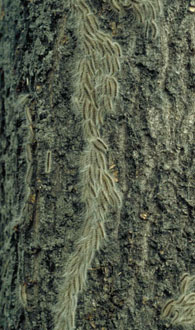Corfe Castle at sunrise
The world famous RHS Chelsea Flower Show will soon be here with its floral exhibits, stands and stalls of every imaginable kind, and of course its amazing gardens. You may be visiting the show to see for yourself, or perhaps enjoying it on television from the comfort of your armchair – but however you get your Chelsea ‘fix’ – look out for Helen’s Oak Processionary Moth Garden in the Fresh Garden Category. Featuring oak trees shrouded in fabric it is sure to be a show stopper.
Award winning landscape and garden designer Helen Elks-Smith is being sponsored by the City of London Corporation to design a garden that raises the profile of the Oak Processionary Moth (OPM)and the very real danger it presents to our native oak trees and our landscape as a whole.
In Helen’s garden, a stand of oak trees is shrouded by textiles to highlight the growing problem of oak processionary moth (OPM). The shrouds wrap around the threatened trees to create unique sculptural forms with an ethereal sensibility. The shrouds symbolise decay, whilst hornbeam columns form barriers. The planting that flows through the gaps between the barriers represents the way in which OPM can take advantage of gaps in its treatment or biosecurity measures. The textiles also echo the idea of cocoons spun around the chrysalis and the white silken webbing nests characteristic of OPM.
What is Oak Processionary Moth and why is it a problem?

OPM caterpillar procession on trunk
It is thought that OPM was first brought into the UK in 2006 on trees imported from the continent. It has now taken hold in sites to the south and west of London and also one in Berkshire. The OPM caterpillars are not just a danger to trees, they can also affect humans, pets and wildlife.
The trees are weakened by the caterpillars feeding on their leaves, and they are then susceptible to disease and changes in their environment. The mature caterpillars are covered in thousands of tiny hairs that are carried in the wind. These hairs contain an irritant called ‘thaumetopoein’ and can cause severe rashes on contact and in some cases eye and breathing problems too.
Can it be controlled?
Yes! When an infection is reported it can be treated with a combination of spraying and removal by hand. There are also a number of biosecurity measures in place to help reduce the chances of spreading infection. These include restricting the movement of trees and the production of plant passports to ensure the health of imported trees, or trees from infected areas.
How can you help?
• Make sure you don’t take any plant matter away with you if you visit an affected area – such as sticks for your dog to play with – you may inadvertently spread the infection.
• Check the oak trees in your garden and surrounding area for signs of the nests and caterpillars so that any infection can be caught early before it spreads.
• If you are planting new oak trees, make sure they are from reputable suppliers and, if from abroad or infected areas in the UK, that they have a plant passport
If you think you have seen OPM caterpillars or nests:
• Do not touch or approach the caterpillars or nests.
• Keep people, pets and animals away from nests, caterpillars and affected trees.
• Go and see your doctor or vet if you are seriously affected by symptoms.
• Report sighting (with photo if possible) to your local council or Forestry Commission opm@forestry.gsi.gov.uk
For further information visit www.forestry.gov.uk/opm
Although OPM is currently only reported to be in the London and Berkshire areas, scientists believe that it could survive and breed in much of England and Wales so we must act now to contain or possibly eradicate it, before it spreads to the wider countryside and changes our landscape for ever.